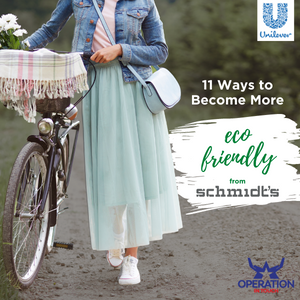
How I’m Transitioning to a Low-Waste Lifestyle
11 easy steps to becoming a more conscious consumer
By Natalie Shukur, writer for The Natural
I have lived many existences in my relatively nomadic life. From being a fashion-obsessed teenager in London, to selling all my possessions and going off the grid to live in the counter-culture communities of Byron Bay and Bali, to a life in New York, where I have learned to counter pervasive consumerism with mindfulness and minimalism.
It’s an interesting time to live in a city that is the crux of capitalism, and yet, is filled with more conscious, activist and liberal people, who care about climate change and the state of our planet, than I have ever come across. Living in New York has also made me more aware of just how much we’re marketed to, and how the “green” movement is tangled up with that. “Green washing” is a thing. A tool to sell so-called “eco-friendly” products and ideas as much as “clean eating” tries to sell us industrialized organic quinoa puffs and paleo muffins.
While it’s a positive sign that New York State is banning single use plastic bags and cities and states like California have banned plastic straws from its restaurants, we need to look beyond those face value tokens — to educate ourselves and be more pragmatic when it comes to making choices that reduce our environmental impact. The penny really dropped for me the other day when I read an article about that bastion of the green movement — the humble canvas tote bag. I have more canvas and cotton tote bags than I care to admit. I am a woman who has tote bags full of tote bags. Many I have inherited from “sustainable” brands in lieu of plastic bags, some I have bought as souvenirs from galleries and restaurants, and many more have been bestowed upon me as a promotional gift (in 2019, the tote bag is the new billboard). But, did you know that cotton requires an obscene amount of energy and water to produce? That it is one of the least environmentally friendly crops and one of the world’s biggest polluters? One study from 2011 revealed that a cotton bag’s carbon footprint is 598.6 pounds of CO2, compared to 3.48 pounds for a standard plastic bag made from high-density polyethylene.
When I lived in the tropics, it was easy to leave a light footprint (literally, I rarely wore shoes at one point). I didn’t need a lot of clothes, ate a vegan diet, and shopped almost exclusively at bulk food co-ops and farmer’s markets. Living in New York, however, requires me to consume more and collect more, but that doesn’t mean I can’t be thoughtful about the waste I’m creating and proactive in reducing it. Here are some of the practices I have incorporated (and you can, too!) that, I hope, make me more respectful and protective of this earth we call home.
- I walk and bike everywhere I can instead of taking cars or public transport.
- I buy grains, nuts, seeds, tea, granola, and other dry goods in bulk whenever I can and store them in reusable glass jars.
- I choose loose fresh produce or shop at the farmer’s market and avoid foods wrapped in unnecessary packaging.
- I’m (now!) super conscious about my bags. I use one or two cotton tote bags until they are beaten to death and then replace. I reuse plastic bags in and around the house and generally try to avoid them altogether.
- I eat a plant-forward diet because the meat, poultry, and dairy industries are some of the world’s biggest polluters.
- I use “natural” beauty and household products that are biodegradable and free of chemicals that pollute our air and waterways.
- I take the train or bus instead of flying when it makes sense. Travel by plane has by far the biggest carbon footprint of most regular activities.
- I buy less stuff and make it last. This is a privileged stance, but I’ve developed a “uniform” and spend more money on fewer pieces that I know I will wear for many years. I repair my clothing and resole my shoes. When it comes to furniture and home goods, I save up for the best quality items that will last — otherwise I do without.
- For my wardrobe and home, I’ve started to switch to hemp, linen, and recycled synthetic fabrics that have a smaller environmental impact than cotton and other materials (bonus: they also last longer).
- I rarely order takeout or food delivery to avoid excess packaging and the transportation it requires.
- I use mason jars for everything: storing food, drinking coffee, and toting my breakfast. There’s no end to their uses and the throwaway packaging they help me avoid.
Editor’s note: Transitioning to a low-waste lifestyle takes time! Try any one of these tips and see what kind of impact it can have on your day. Every step counts.
Read the original article by clicking here. (Link opens in new window.)


